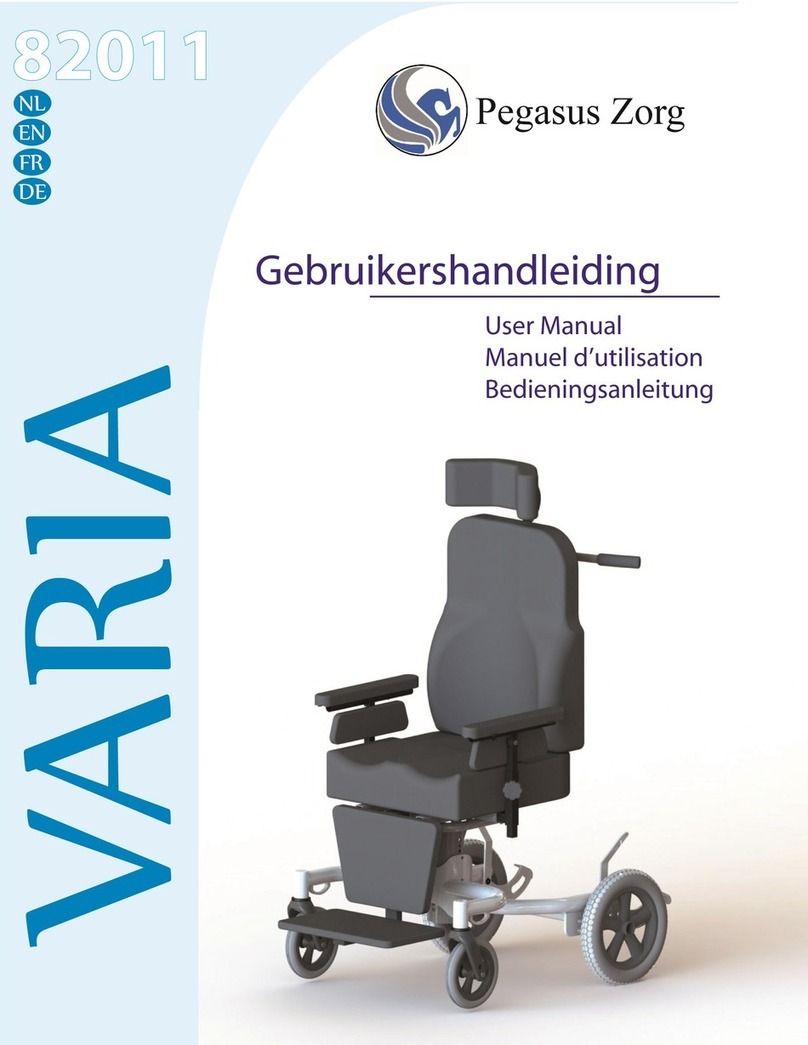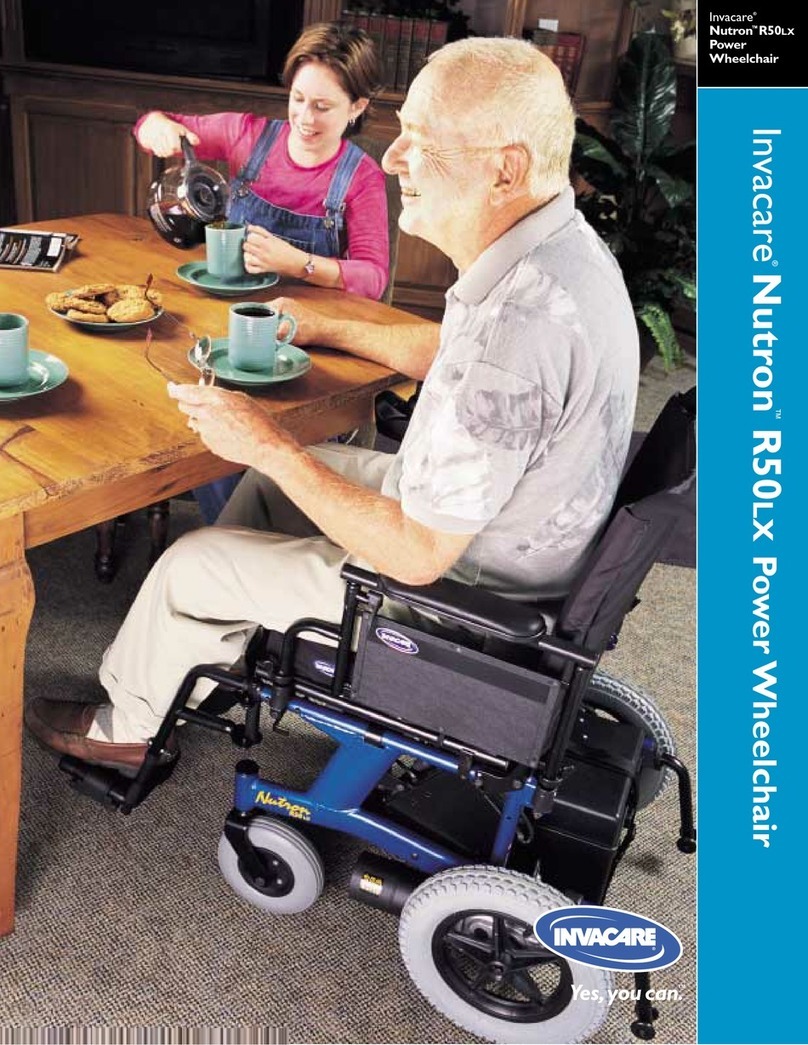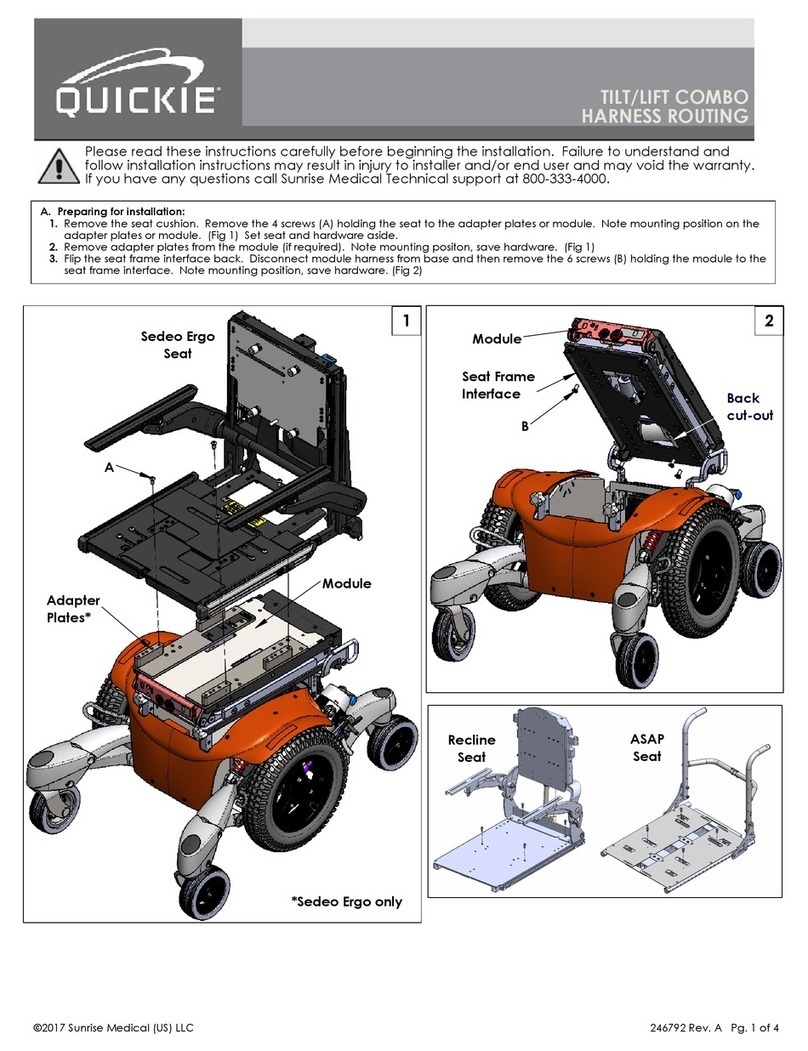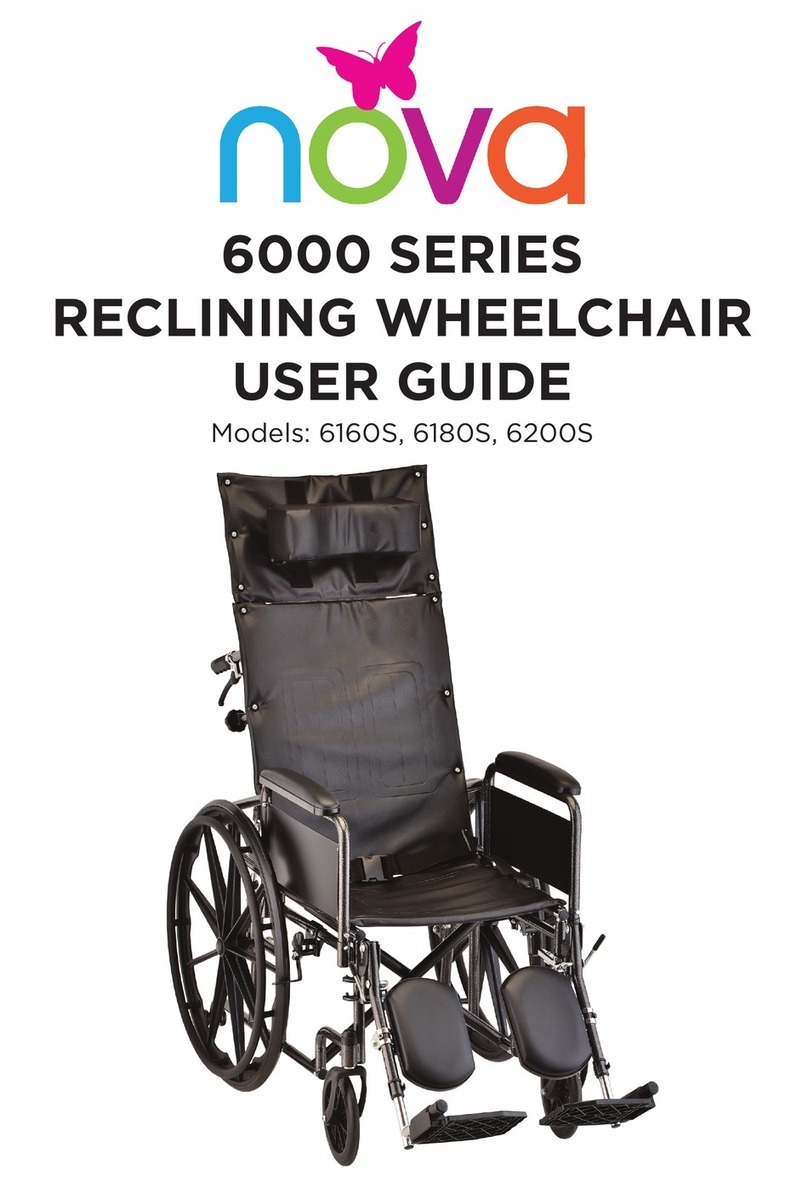Foldawheel Phoenix User manual

V2.0
User Manual
Phoenix

01
TABLE OF CONTENTS
Title Page
Parts Introduction 02
1.0 Safety Tips 03 - 04
Standing
Important point to note for operating the wheelchair
Safety information on driving and free-wheel mode
Rear wheels
Armrests
Power drive attachments
Modifications
2.0 Set Up Upon Arrival 05
The original package and accessories
Unfolding the stand up wheelchair
3.0 Adjustment 06 - 08
Adjusting the seat depth
Adjusting the footrest height
Adjusting the footrest angle
The knee support and belts
Adjusting the armrest height
4.0 Driving 09 - 10
Before driving for the first time
Taking obstacles
Driving up and down gradients
Free wheel
5.0 Control System 10 - 14
The Dynamic SHARK remote
Battery and control box connection
Battery charger
Main circuit breaker
The lock for Controller & to operate the lights
Flash Codes
6.0 Maintenance

PARTS INTRODUCTION
02
01
02
03
04
05
06
13
14
08
10
11
12
07
09

03
- Standing up stresses your body in ways you may not be used to. Therefore we
recommend you consult your doctor or physical therapist before using the
stand-up wheelchair.
- Before using the standing wheelchair, it is absolutely vital that the knee support,
safety belt and chest belt are xed correctly.
Switch on the master power switch before using. (see P9)
- Before using the stand up wheelchair, you should be familiar with
the operation and the function.
- Use only on standard household, and hard and even ground. Not to be used on
a wet surface.
- In case of staircase, the stand up wheelchair must be carried by 4 persons.
- When getting on or off the stand up wheelchair, do not put the foot on the
footrest, to avoid danger.
1-1. Standing
Attention :
Warning : Maximum weight should not exceed 250 lbs.(120 kg)
DO NOT DRIVE OVER UNEVEN GROUND!
Danger of tipping over!
DO NOT LEAN OUT OF THE RAISED VERTICALIZER!
Danger of tipping over!
NEVER DRIVE ON ASCENDING OR DOWNWARD SLOPES
WHEN THE VERTICALIZER IS RAISED!
Danger of tipping over!
NEVER REACH INTO THE MOVING APPARATUS OF THE
RAISED VERTICALIZER!
Danger of crushing!
1-2. Important point to note for operating the wheelchair
The following actions should not be attempted :
1.0 SAFETY TIPS

* Only ever drive downhill at a maximum of 1/5 of the top speed! Avoid abrupt
braking or acceleration on gradients.
* If at all possible, avoid driving on slippery surface (such as gravel) where there is a
danger of you losing control over the wheelchair, especially on a gradient! If driving
on such a surface is inevitable, then always drive slower and with the utmost caution.
* Never attempt to overcome an obstacle when on an uphill or downhill gradient!
* Never attempt to drive up or down a ight of steps with your wheelchair!
* Always approach straight on! Ensure that the front wheels and rear wheels move
over the obstacle in one stroke! Do not stop halfway! Do not exceed the maximum
obstacle height!
* Avoid shifting your center of gravity, or abrupt joystick movements and
changing of direction when the wheelchair is in motion!
* Never use the wheelchair to transport more than one person!
* Note that the wheelchair will brake or accelerate if you change the Driving Mode
whilst the wheelchair is in motion!
Always practice with your Healthcare professional or attendant. Before attempting
to negotiate curbs, inclines or ramps alone, it is important for you to develop a safe
technique that is suitable to your abilities.
1-3. Safety Information on Driving and Free wheel Mode
1-4. Rear Wheels
Danger of injury if the wheelchair tips over
Curbs, inclines and ramps
Never lift the wheelchair by the ip-back armrests. These parts are detachable and
lifting the wheelchair by them may cause damage to the chair or injury to the user.
1-5. Armrests
Flip-back armrests
Power standing wheelchair does not advocate the use of power drive attachments on
any power wheelchair. Use of a power drive attachment on wheelchair alters its
intended use. Installation of a power drive attachments is considered an alteration to
the frame and voids the warranty.
1-6. Power Drive Attachments
Marketing any unauthorized modications or using parts not supplied by
technical personnel may change the whelchair structure and create an unsafe
condition, thus voiding the warranty.
1-7. Modifications
Doing a “wheelie”(tilting the wheelchair backward to its balance point) can be dangerous.
Do not attempt this maneuver without an attendant.
Warning :
1.0 SAFETY TIPS
04

~ Power stand up wheelchair, joystick, heel strap & chest belt
~ Knee support & headrest
~ Charger
~ User manual and tool
~ Options as ordered
Remove any transport straps or transport guards
2-1. The Original Package And Accessories
2-1. Unfolding The Stand Up Wheelchair
The Original Package And Accessories Contain The Following Components :
1) Remove any transport straps or transport guards.(P1)
2) Grasp the wheelchair at the backrest and pull backward up . (P2)
3) Tighten the knob of left and right. (P3)
4) Put down the armrest and connect the actuator to the back rest and tighten it up. (p4~P6)
5) Connect both side armrest to the seat frame.(P7~P8)
6) Install the headrest and secure it with the knob.(P9~P10)
7) Pull up the side panel and thighten the knob.(P11)
Backrest Assembly Instructions :
2.0 SET UP UPON ARRIVALS
P1 P2 P3 P4
P5 P6 P7 P8
P10P9 P11
05
Set-up Video QR Code

Should you require adjustments and alterations to the mechanism of the wheelchair,
or any maintenance work, please contact qualified technicians.
- Push the Joystick forward to raise the wheelchair frame.(P12)
- After loosening the left(right)both side screws, the seat depth can be adjusted .
Each holes are 1”difference.(P13)
-One of the screws on the right has a nut behind it. Use a spanner to loosen it.(P14)
- Retighten the left(right)screws on both side.(P15~P16)
Theheightofthefootrestisadjustableandshouldbealteredinlinewithyour
bodyproportionstoguaranteethebeststandingpositionpossible.Footrest
adjustmentshouldalsotakeintoaccountyourchoiceofseatcushion.
- Afterlooseningthescrews(bothsides)theFootrestheightcanbeadjusted.
Eachholesare2cmdifference.
- Retightenthescrewsatyourdesireheight.
3-1. Adjusting The Seat Depth
3-2. Adjusting The Footrest Height
P12
P15
P14
P16
P17 P18
P13
3.0 ADJUSTMENT
06

3-3. Adjusting The Footrest Angle
3-4-2. Chest Belt
- After releasing the screws, the footplate angle can be adjusted using the different
hole at 3 range incline angle.(P19 ~ 21)
- Retighten the screws.
P19 P20 P21
-Makesurethatthechestbeltissecuredonthe
backrestʼsvelcrostrap.
-Thechestbeltistoholdtheupperbody(chest)
inplace.
3-4. Knee Support And Belts
3-4-1. Knee Belt
The most important safety features of the stand-up wheelchairs are the knee
support, safety belt and chest belt. It is absolutely essential that these are correctly
in place before you attempt to stand up.
The knee support holds the knees in an extended posture and prevents you
from slipping out of the wheelchair while standing up.
Attach the two triangular clasp of the knee belt
tonto the seat frame, on both side of the wheelchair.
Center the knee belt in front of your knee, pull the
velcro belt until it is sitting firmly in place, then attach
the other clasp onto the frame. Knee belt should be
just below (not right on) the knee cap and not too tight.
3.0 ADJUSTMENT
07
Low Medium High

3-4-4. Safety Belt
3-4-3. H-Belt
- The safety belt holds the waist in place.
-Make sure that the safety belt is secured on the the backrest’s velcro .
- Close the catch on the safety belt and pull it but not too tight.
-To release the safety belt., simply press the red button in the center of the catch.
- The H-belt holds the upper body in place.
- Close the catch on the belt and pull the strap to tighten. (not too tight)
-To release the safety belt, press the top and bottom part of the center of the catch.
3.0 ADJUSTMENT
3-5. Adjusting The Armrest Height
1) Remove A screws and loosen B screws.
2) Adjust the Armrest to the desired height.
3) Secure screws A
4) Tighten screws B
08
B
A
1
3 4
2

4-1. Before Driving for the First Time
Make sure :
Before you take your first trip, you should familiarize yourself with the
operation of the vehicle and with all operating elements. Take your time to
test all functions and driving modes.
4-2-1. Driving up and down gradients
Your electric wheelchair has a maximum tilt-resistant climbing ability of
10 degrees.
* You are within easy reach of all operating controls.
* The battery charge is sufficient for the distance intended to be covered.
* The restraining belt is in perfect order.
Warning :
* Never approach obstacles at an angle!
* Put your backrest into an upright position before climbing an obstacle!
* Never drive over obstacles with an erected vertical(standing position).
* Only ever drive obstacles at a maximum of 1/5 of the top speed! Avoid abrupt
braking or acceleration on gradients.
Warning :
* Only ever drive downhill at a maximum of 1/5 of the top speed.
* Avoid sudden changes of direction or abrupt braking when driving on slopes.
* Always return the backrest of your seat to an upright position before ascending
slopes. We recommend that you position the seat backrest slightly to the rear
before descending slopes.
* If the lifter is raised, drive mode is only used for positioning and not for regular
drive operation. Lower the lifter before ascending a slope.
* Never attempt to ascend or descend a slope on slippery surfaces or where there
is a danger of skidding.
* Avoid trying to get out of the vehicle from an incline or a gradient.
* Always drive straight in the direction of the road or path you are going,
rather than attempting to zigzag.
* Never attempt to turn around on an incline or a slope.
Danger :
* When the seat is raised, drive operation only serves positioning, not driving.
* Never driven over uneven ground on an upward or downward slope obstacles.
4-2. Before Driving for the First Time
- Your electric wheelchair is able to overcome obstacles and curbstones to
a maximum height of 5 cm.
- When driving in standing position, speed is limited to 1/5 of the
maximum speed.
4.0 DRIVING
09

4.0 DRIVING
4-3. Free Wheel
The motors are designed to engage the electromagnetic brakes
when the vehicle is not in use or when the power is OFF. There is also a
manual feature that allows the unit to “freewheel”. Free-wheeling is
accomplished by pulling the free-wheeling levers to the free-wheeling position.
Warning :
* Never free-wheel your power wheelchair on a slope.
* Never free-wheel the motors while operating your vehicle.
* Always remember to engage the motors before turning the power back ON
5.0 CONTROL SYSTEM
Master Power Switch
* Switch on the master power before using.
Manual mode Power mode
1.Combined charging socket/
programming socket
10

5-1. The Dynamic SHARK Remote
1. Battery gauge
2. Battery Empty
3. Left Signal Indicator
4. (1)Standup Actuator
5. Horn
6. Slower Max Speed
7. Attendant Profile LED
8. Left Signal
9. Hazard Lights
10. Fault Indicator LED
11. On/Off
12. Battery Full
13. Right Signal LED
14. (2)Recline Actuator
15. Speedometer
16. Faster Max Speed
17. LED Lights
18. Right Signal
19. Side Lights Indicator
20. Joystick
1
2
3
4
5
6
7
9
10
11
12
13
14
15
16
17
18
19
20
8
5-2. Standing and Reclining
To stand, press 1 and tilt the joystick
forward. To go back to sitting position,
tilt the joystick backward.
To recline, press 2 and tilt the joystick
backward, to go back to upright
position, tilt the joystick forward.
5.0 CONTROL SYSTEM
11
Forward
Backward
Forward
Backward

5-3. Battery and Control Connection
The main electrical system is composed of the motor, control box battery and
controller. The connection of the control system is as below :
5-4. Battery Charger
1. First, connect the battery charger line to the battery DC power socket and make
sure the line is connectly.
2. Connect the AC power line to the AC socket. (110~ 230V)
3. The light of bettery charger from yellow to green when the battery is fully charged.
*When the battery capacity is empty power, it will stop working.
Battery capacity
indictor color Power condition
Green Full power
Yellow Low power
Red Empty power
5.0 CONTROL SYSTEM
12

5-5. The Lock for Controller
5-6. To operate the lights
Press the side light button to switch the
Head(L/R)/Tail(L/R) lights on or off.
• The side light LED is on when the
sidelights are switched on.
Press the indicator buttons to switch the
indicators on or off.
• The indicator LEDs flash at the same rate
as the indicator lights.
The indicators will switch off automatically.
Press the hazard light button to switch the
hazard lights on or off.
• Both indicator LEDs flash together at the
same rate as the indicator lights.
5.0 CONTROL SYSTEM
13

5.0 CONTROL SYSTEM
Flash codes indicate the nature of an abnormal condition
directlyfromthe SHARK Information Gauge. Without the use of
any servicing tools, the cond ition can be diagnosed easily.
Flash
Code
Description Suggestion/ Diagnose
1 User Fault Possible stall timeout or user error.
Release the joystick to neutral and try again.
2 Battery Fault Try charging the batteries.
Batteries may require replacing.
Check the batteries and cabling.
3 Left Motor Fault Check the left motor, connectionsand cabling.
4 Right Motor Fault Check the right motor, connections and cabling.
5 Left Park Brake Fault Check the left park brake, connections
6 Right Park Brake Fault Check the right park brake,connection and cabling
and cabling.
7 SHARK Remote Fault Check theSHARK Communications Bus connect
wiring. Replace the Remote.
8 SHARK Power Module
Fault
Check SHARK connections and wiring.
Replace the Power Module.
9 SHARK
Communications
Fault
Check Battery voltage is greater than 17V.
Check SHARK Bus Cable.
Replace the SHARK Power Module.
Replace the SHARK Remote.
10 Unknown Fault Check all connections and wiring.
Consult a service agent.
11 Incompatible Remote The Remoteis incompatible with the Power Module.
Ensure the brand ofthe Power Module matchesthe Remote
5-7. Flash Code
14

6.0 MAINTENANCE
When cleaning your Standing Wheelchair use a dry or slightly moistened
cloth to wipe the wheelchair down. For stubborn or oily stains, apply a mild
detergent to the cloth. Do not hose down your wheelchair with water.
Check the state of the tread on the tyres every one to six months. If a tyre is heavily
or unevenly worn, it should be replaced.
According to frequency of use, lubricate the joints once a week and once
a month. (Joints shown below)
Wheelchair88 Ltd.
wheelchair88.com
+60-3-3318 3133
Advanced Mobility Technology
@WheelChair88
Table of contents
Other Foldawheel Wheelchair manuals
Popular Wheelchair manuals by other brands

Eloflex
Eloflex H instruction manual
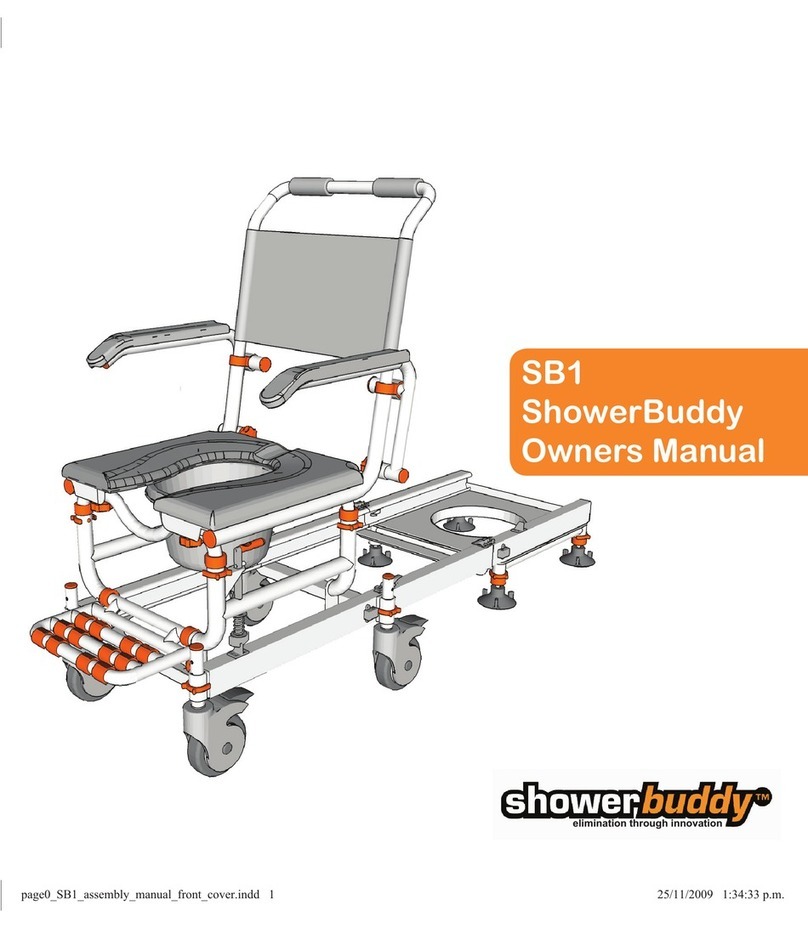
Showerbuddy
Showerbuddy SB1 owner's manual
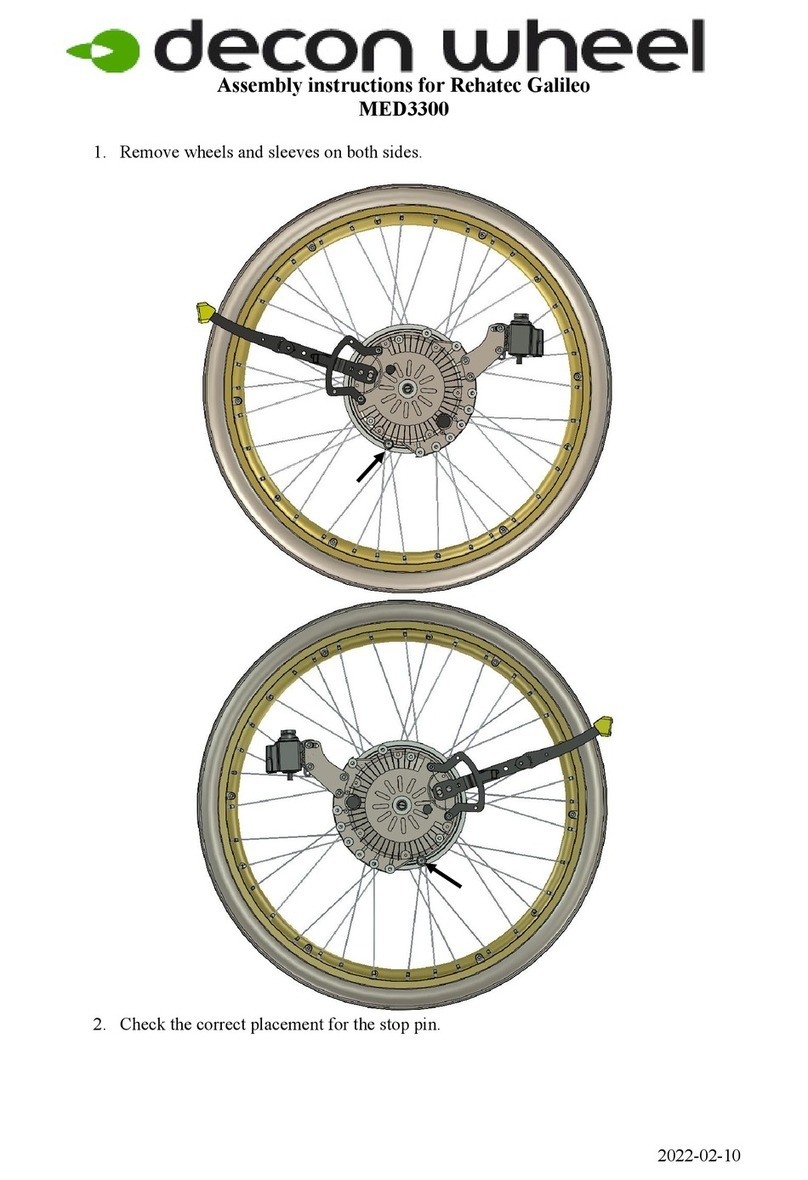
Decon wheel
Decon wheel Rehatec Galileo Assembly instructions

Everest & Jennings
Everest & Jennings 12022010 Operation manual
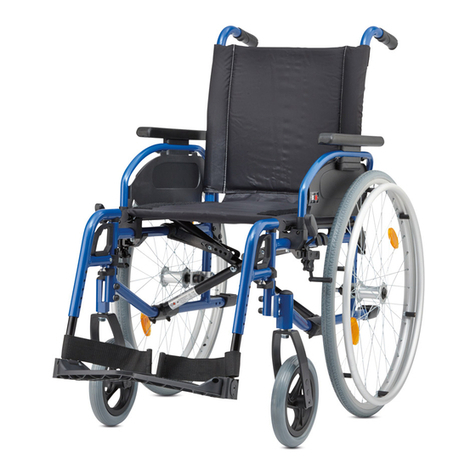
Bischoff & Bischoff
Bischoff & Bischoff Pyro Start Plus instruction manual

EZee Life
EZee Life EZee Fold 2G Series user manual






